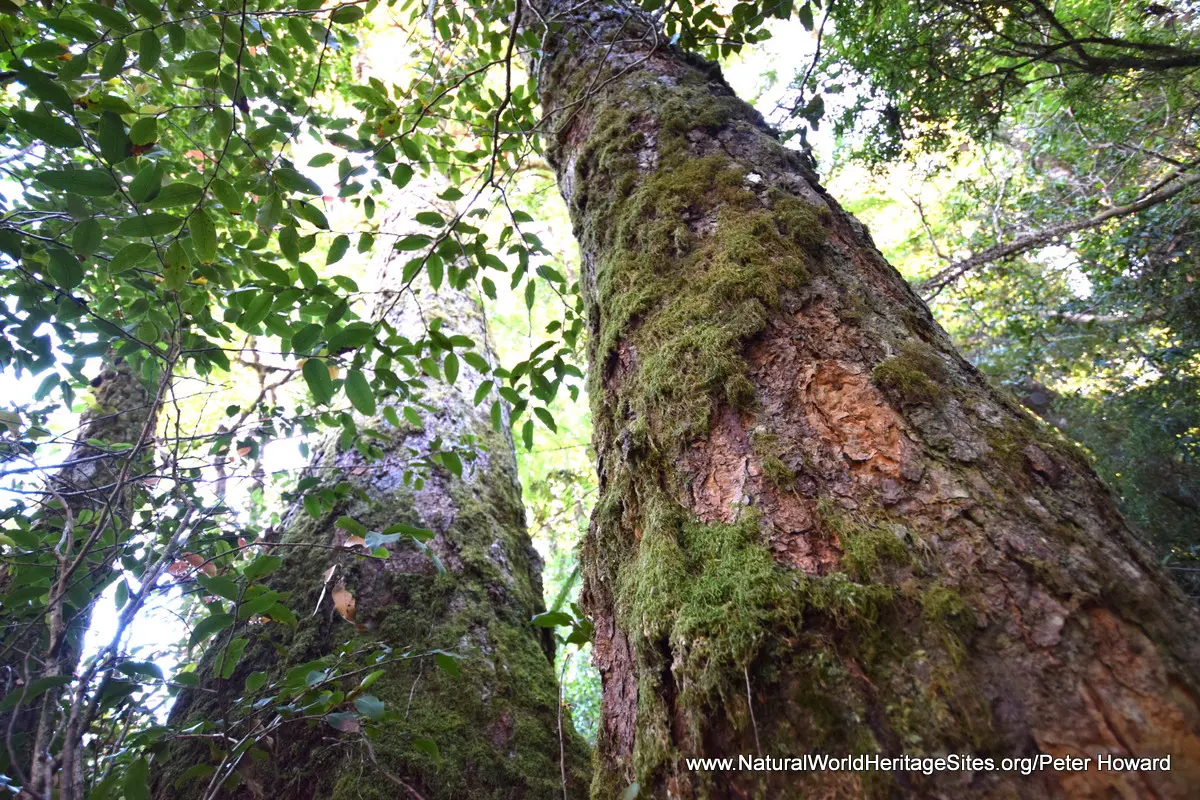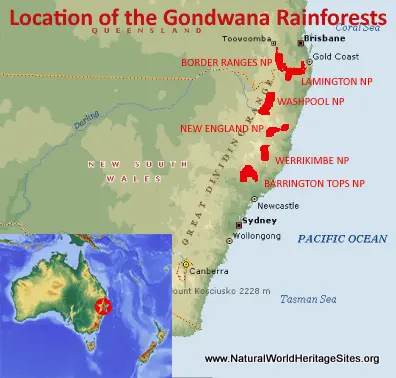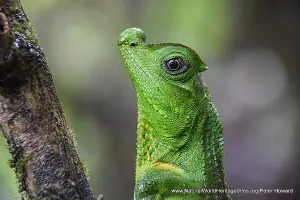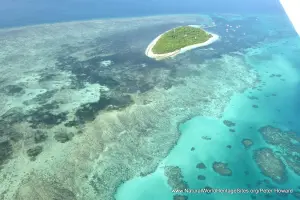EXPLORE the Gondwana Rainforests of Australia with this slideshow, check the location map and get all the facts and information below.
For slideshow description see right or scroll down (mobile). Click to view slideshow
Location and Values: The Gondwana Rainforests of Australia are represented by a network of 41 separate reserves, scattered as an archipelago of habitat islands along Australia’s eastern escarpment in southern Queensland and north-eastern New South Wales. These small remaining fragments of rainforest habitat serve as refugia for many species that were once widespread across the continent, but have become progressively restricted as the Australian climate has become drier. The Gondwana rainforests lie between the dry sclerophyll Eucalypt forests of the Greater Blue Mountains Area to the south and the Wet Tropics of Queensland to the north. They are globally important in understanding the break-up of the Gondwanan supercontinent, subsequent development of a sequence of volcanoes in this part of Australia, and the present-day distribution of particular ‘relict’ species characteristic of the ancient supercontinent and early periods in the Earth’s evolutionary history. The diversity of ferns, primitive conifers (Araucaria) and representatives of the oldest lineages of passerine birds (including lyrebirds, bowerbirds and catbirds) provide evidence of this long and interesting evolutionary history. The Gondwana rainforests world heritage site encompasses a particularly diverse range of habitats with several distinct types of rainforest (subtropical, warm temperate, cool temperate and Araucarian) alongside a diverse range of heaths, rocky outcrop communities and woodlands.
Conservation Status and Prospects. According to IUCN’s Conservation Outlook Assessment (2017) the conservation status of the Gondwana Rainforests of Australia is ‘good with some concerns’. The IUCN report notes that ‘The Gondwana Rainforests is a serial property composed of 41 component parts, ranging in size from 36 hectares to 39,120 hectares. Each of the component parts conserve different values and are faced with different threats and management responses. In general, the values for which the site was inscribed on the World Heritage List in 1986, with a large extension in 1994, have been mostly maintained apart from a decline in some significant species. While management has so far been effective in addressing some challenges, further management responses will be required to address some increasing threats, particularly those posed by invasive species and pathogens and climate change. ’
Links:
Google Earth
Official UNESCO Site Details
IUCN Conservation Outlook
UNEP-WCMC Site Description
Birdlife IBA
The slideshow ‘tells the story’ of the Gondwana Rainforests of Australia with a portfolio of photos by Peter Howard from a visit to the Border Ranges and Lamington National Parks in January 2018. It starts in the Border Ranges, where a scenic drive provides unique access to the pristine interior of the rainforest, through a range of different vegetation communities featuring an abundance of palms, ferns and other relict flora. The road reaches the spectacular Pinnacle Lookout on the edge of escarpment, overlooking the prominent volcanic mountain mass of Wollumbin/Mt Warning (considered to be the best preserved erosion caldera in the world; see also the satellite image in the Google Earth link alongside). From the lookout the road continues a short distance to a beech glade nature trail, where ancient trees of Antarctic Beech (Nothofagus moorei) are found in the cool temperate climate of the escarpment rim.
Descending out of the hills of the border ranges, much of the landscape has been cleared of trees and converted to pasture. Three quarters of the rainforest that existed in Australia at the time of European arrival has been cleared in this way. In the surrounding lowlands (and the drier parts of the Gondwana Rainforests world heritage site), Eucalypt forest replaces the closed rainforest communities and these are areas where Australia’s iconic mammals – the koala and echidna (an egg-laying monotreme) – might be encountered.
The slideshow continues with a series of photos illustrating some of the key flora and fauna in Lamington National park, centred on the Green Mountains Section of the park and the facilities around O’Reilly’s Rainforest Retreat. Here there is a superb ‘Tree Top Walk’, which enables visitors to walk through the rainforest canopy (and even climb out into the high branches of an emergent tree for far-reaching views over the wider landscape). In this part of the park, the courtship grounds of bower birds can be found (perhaps, as in the photo here, decorated with blue bottle tops and plastic straws rather than more natural items!) and a wealth of other rainforest birds from brushturkeys to parrots are easily observed. Trails lead through the rainforest where vaste Hoop pine (Aruacaria cunninghamii) and fig trees are encountered and scenic spots around splendid waterfalls (such as the Elabana Falls) provide opportunities to stop and observe life in the rainforest.
Factfile
Website Category: Tropical & Sub-tropical Forests
Area: 3,700 km2
Inscribed: 1986
Criteria:
- Geological features (viii);
- Ecological processes (ix);
- Natural habitat for biodiversity (x);
- Significant number of rare, endemic and/or endangered species (x)





